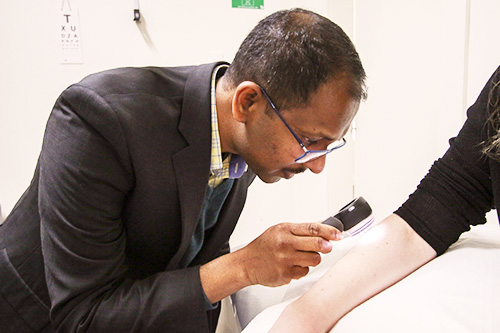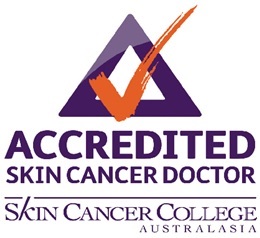Skin Cancer

Better health Medical Centre now offers a skin cancer surveillance and treatment service. Dr James is an accredited skin cancer specialist.
We do whole body skin cancer checks. We provide best quality care for the treatment of melanoma, squamous cell carcinoma, basal cell carcinoma, keratoacanthoma, Bowen’s disease as well as rarer skin tumours.
Treatments that can be provided include:
-
surgery
-
cryotherapy
-
topical immunotherapy
-
topical chemotherapy and
-
diathermy
Diagnostic services include detailed skin check with dermoscopic examination of the lesions biopsies and skin photography.
Read about us in the Shepparton Adviser
What you need to know about Skin cancer
Skin Cancer is very common
- Australia and New Zealand have the highest incidence of skin cancer in the world.
- Skin cancers account for around 80% of all newly diagnosed cancers.
- More than 90% of skin cancers are caused by exposure to the sun.
Protect Your Skin from the Sun
Exposure to ultraviolet (UV) radiation is the leading cause of skin cancer. There are 2 types of UV radiation:
- Ultraviolet A (UVA). UVA radiation can pass through glass. Research suggests that it may:
- Cause premature aging and wrinkling of the skin.
- Play a role in causing basal cell carcinoma, squamous cell carcinoma, and melanoma.
- Ultraviolet B (UVB). UVB does not pass through car windows or other types of glass. UVB radiation:
- Is more closely linked with the development of skin cancer and melanoma and Causes sunburn.
It is important to protect your skin from both UVA and UVB radiation.
Tips for using sunscreen
- Sun damage builds up over time. It is important to use sunscreen every day, even if it is cloudy.
- Choose a broad-spectrum sunscreen that protects against both UVA and UVB radiation. Make sure it is water resistant and has a sun protection factor (SPF) of 30 or higher. Other types of sunscreen may help prevent sunburn, but they will not protect against skin cancer.
- Use a lip balm or lipstick that contains sunscreen with an SPF of at least 30
- Apply at least 1 ounce of sunscreen 15 to 30 minutes before going outdoors. One ounce is enough sunscreen to fill a shot glass
- Reapply sunscreen to your entire body every 2 hours. Reapply every hour if you are swimming or sweating
- Sunscreen creams are better for dry skin. Gels are better for the scalp or hairy areas
- Wear sunscreen year-round whenever you are outside
- Do not use sunscreens that have expired
Other sun protection tips
- Limit sun exposure. The sun’s rays are the most intense between 10:00 AM and 4:00 PM. Practice the shadow rule: if your shadow is shorter than you, you should find shade. Always keep babies younger than 6 months old completely covered and in the shade.
- Pay attention to the UV index. This numbered scale measures how damaging exposure to the sun will be on any particular day. It is often included in the weather report. When the index is 10 or higher, people should try to stay indoors.
- Be careful around reflective surfaces. Water, snow, and sand reflect the damaging rays of the sun and increase your risk of getting sunburned.
- Wear protective clothing and sunglasses. Make sure you have a long-sleeved shirt, long pants, and a hat that shades the face, neck, and ears. Dark clothing with tightly woven fabric blocks more sun than white or loosely woven fabrics. For additional protection, look for clothing made with special sun-protective materials. Make sure your sunglasses have 99% to 100% UV absorption.
- Be aware of medication side effects. Some medications may make you more sensitive to the sun. These include specific types of antibiotics, anti-inflammatories, antifungals, blood pressure medications, and some types of chemotherapy.
- Avoid recreational sunbathing. Also, do not use sun lamps, tanning beds, or tanning salons.
SCAN YOUR SKIN
AND LOOK FOR A SPOT OR A MOLE THAT IS…
SORE
A spot which is sore (scaly, itchy, bleeding tender) and does not heal within 6 weeks.
CHANGING
Changing in size, shape, colour or texture.
ABNORMAL
Looks different, feels different, or stands out when compared to your other spots and moles.
NEW
Has appeared on your skin recently. Any new moles or spots should be checked, especially if you are over 40.
A Skin Check can save your Life.
What happens during a skin check?
A skin check can take up to 30 minutes. This includes some time for the doctor to ask you questions about your general health. Make sure you tell the doctor about any spots or moles you have which are Sore, Changing, Abnormal or New. The actual check of your skin can take from 5 to 20 minutes depending on your skin type and the number of moles and spots to be looked at.
What equipment does the doctor use?
Your doctor will use a dermatoscope to have a close up / magnified look at any spots of concern. A dermatoscope is a bit like a torch with a magnifying glass attached to the end. Using a dermatoscope is painless. Sometimes the doctor may take a photograph of a spot or mole so it can be monitored over time for any changes in appearance.
Do I have to get undressed?
Yes – down to your underwear.
What happens if the doctor finds anything which could be skin cancer?
Your doctor will tell you straight away if you have any moles or spots which require testing. To test the mole or spot the doctor will either take a small biopsy (sample) of it, or completely excise (cut out) the spot of concern – under local anaesthetic of course. In most cases another appointment will be made to remove the abnormal mole or spot. This type of minor surgery can be carried out at your doctor’s surgery or office. There is usually no need for this to be done in a hospital.
After it is removed, the mole or spot is sent to a pathology laboratory for testing. Receiving the test results can take from one to several days, depending on the pathology provider.
What happens if skin cancer is found?
In most cases, when found early, skin cancer can be easily and successfully treated with surgery. Most skin cancers are cured once they are removed. Other non-surgical treatments such as creams, radiotherapy, or light therapy may be used but this will depend on the type of skin cancer found.
What happens after the skin check?
Depending on your level of risk for developing skin cancer, your doctor may recommend regular follow up skin checks. The frequency for follow up skin checks can vary from every few months, to once every year or two. Most doctors will have a system in place to send you a skin check reminder, but it is also a good idea to keep your own record of when a follow up skin check is due.
How much does a skin check cost?
The cost for a skin check will vary depending on the practice or clinic you visit. Within Australia, if you hold a valid Medicare card, in most cases you will be able to claim for a rebate.


